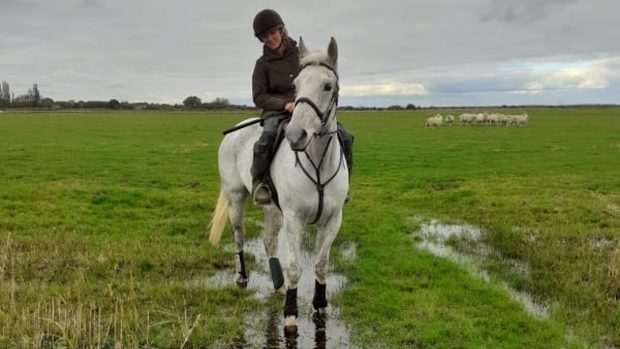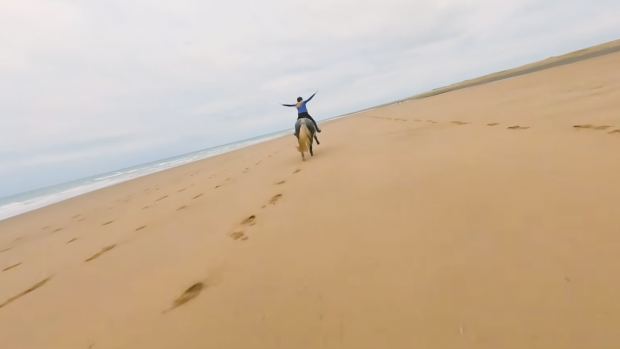Exercising horses on the beach is more than wish list fodder for riders — the health benefits for equine athletes in all disciplines are in high demand
Beach riding — a bucket-list staple for the non-horsey to the seasoned equestrian. But beyond the romantic picture of riding through the surf, there are those actively seeking the powers of this natural resource with training in mind.
From the refreshing sense of wellbeing that Britain’s wild beaches can bring, to using the water as a tool to build strength in sport horses, there are a variety of reasons why some riders turn to the coast.
1. A change of scene
Eventer and showing producer Amy Tough, whose CV features multiple Horse of the Year Show victories, is based on the Pembrokeshire coast, a national park since 1952. “It is always great to give the horses a nice day out and a change of scene; they really enjoy it,” says Amy.
“We tend to be down at the sea once a week during the spring and throughout the winter.
“The tide comes over the whole beach when it comes in and where the sand has dried out it can be very compact and too hard to canter on. We work the horses just a couple of inches deep into the water because then the going is really good.”
2. Fitness work
For Barbadian eventing team trainer Joss Gray, the tropical waters of the Caribbean sea are a vital tool in fittening work, swimming the horses for about five minutes at a time.
“Here in Barbados we have really hard ground and the surfaces are a bit deep,” he says. “Being able to swim the horses is a godsend.”
3. Strengthening work
As well as fittening, Amy uses the shallows for help with slow strengthening work and the beach also provides great education for young horses.
“It is a really good way to introduce them to water,” she says.
The increase in resistance and depth of the water encourages a horse to use himself more and stretch over his back, helping to strengthen muscles.
4. The cold water can help sooth injuries
The cold temperature and salt content of sea water is also known to soothe injuries and help the healing of skin complaints.
“Saltwater — if clean — is cooling and beneficial to some limb injuries, which is why the saltwater spas have become popular,” says H&H’s vet Karen Coumbe.
5. Preparation for travelling to big events
As well as providing a change of scene and helping with strengthening, racehorse trainer Richard Rowe uses seaside trips to help young horses to relax when travelling, as they learn that going in the horsebox is not always associated with the pressures of raceday.
6. The perfect celebration
For owners and horses connected with the showing supremo Hood family, the Holkham beach trip has become an annual highlight at the end of a busy season.
When the tide is out, the north Norfolk beach is a spectacular endless swathe of golden sand, broken by soft dunes and edged with a pine forest.
“We started it the year before last,” says Allister. “It was nice for the clients to have a day out after the season had finished.
“Several of our owner-riders ride their own horses while others come on foot with their dogs.” The day starts with a tot of sloe gin, before the riders and walkers head off for a steady hack along the water’s edge.
“It is a treat for the horses and a treat for the riders,” says Allister.
Like this? You may also enjoy…

Riding on the beach: plan a trip to Holkham
Plan your trip, box-up, hold on to a

Go on a pub ride — and other ways to make the most of the warm weather
From pubs to beaches, there are plenty of
Safety
While an endless expanse of sand might seem idyllic, there are hazards.
Amy stresses the importance of knowing your beach, the tides, the surface and to be aware of stones and rip-currents that may cause problems underfoot.
Some horses can take time to get their bearings with the movement of the waves — plus added surprises such as kite-surfers can be “quite exciting”, says Amy.
Vet Karen Coumbe also offers a word of caution to those not experienced in working their horses on beaches.
“There is always the risk of potential unseen hazards underwater,” she says, warning that unpredictable surfaces — such as a sandy beach — create a risk of limb trauma, particularly soft-tissue injuries, when travelling at speed.
“I may be biased, however, as I tend to see horses when they are injured after a seaside gallop,” she adds. “I realise that I do not see all the others who have successfully exercised while paddling in the sea.”
The full version of this article was published in the 25 May 2017 issue of Horse & Hound magazine





